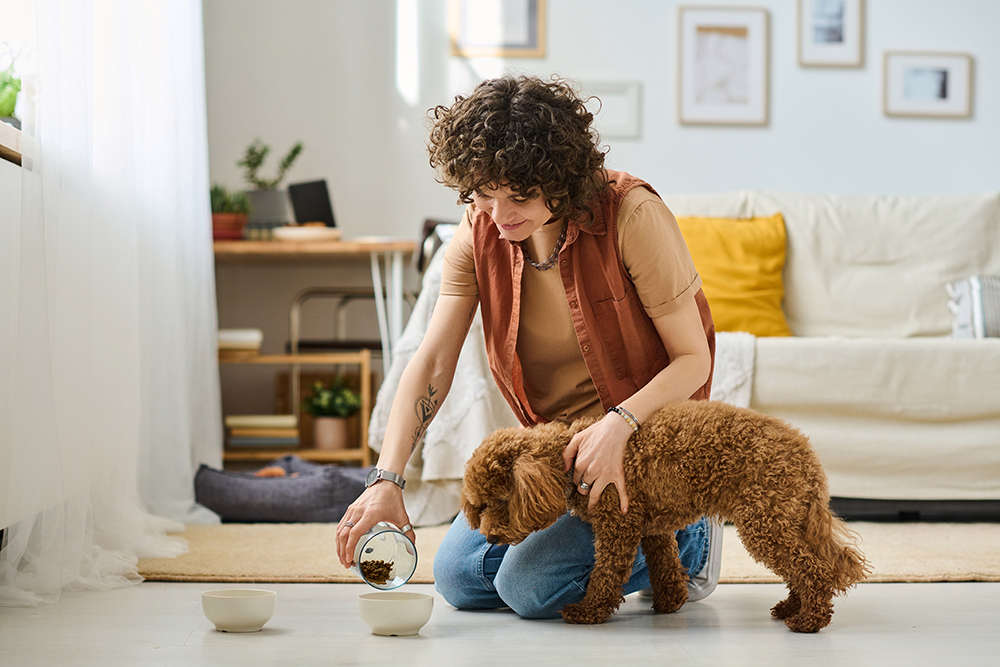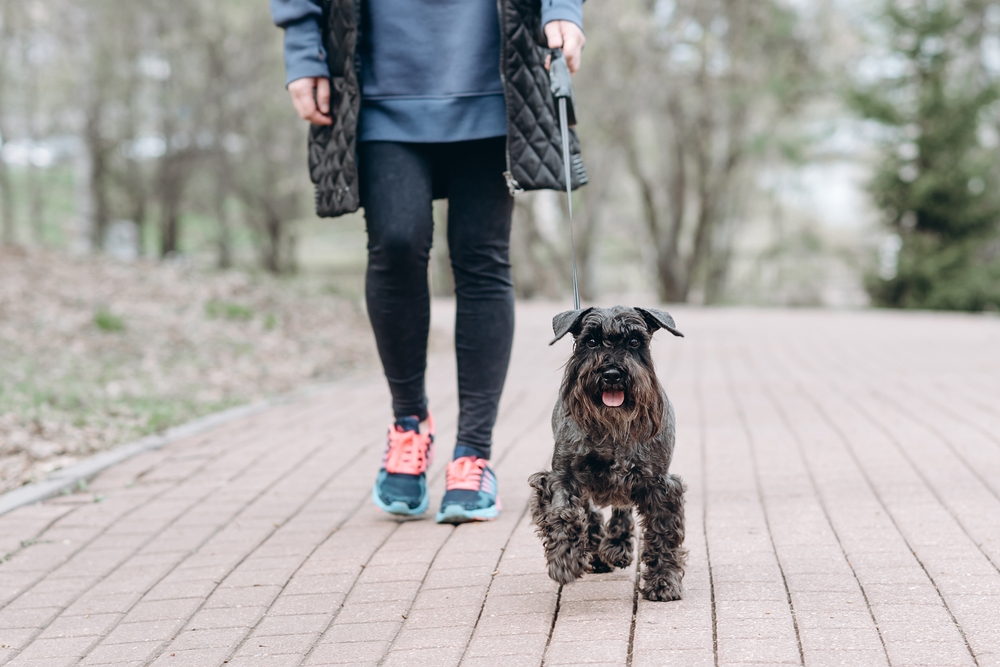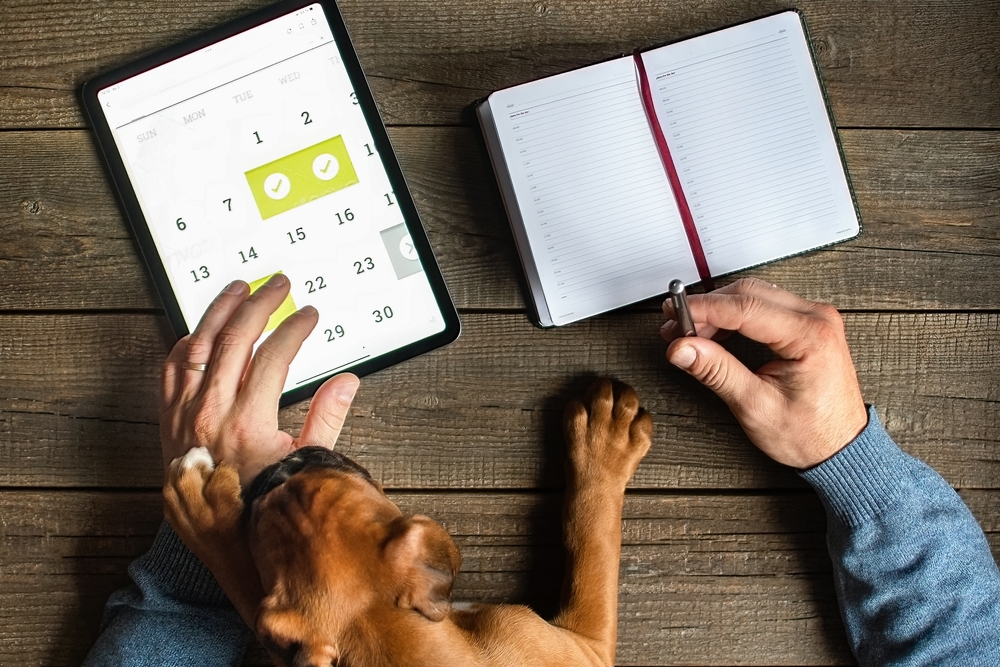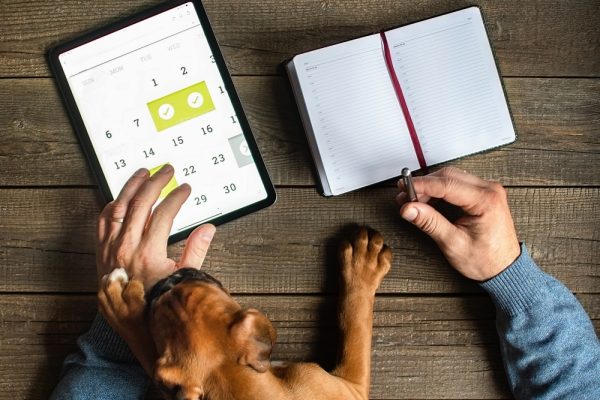Click to Skip Ahead
Canines thrive on routines when living in domesticated households. Without a schedule to rely on, dogs don’t know what to expect. It can similarly be tough for us humans to make sure all our canine companions’ needs are being met.
A daily dog schedule is a great way to make sure the humans and dogs in a household all stay on track and enjoy happy, healthy lives together. Here’s how to make one!
Why a Daily Dog Schedule Is Important
A daily routine helps enhance a dog’s mental and physical well-being. A regular schedule of eating, exercising, and even playing can support a healthy metabolism and ensure that their digestion stays regular due to reliable potty break opportunities. A daily schedule also helps ensure that exercise is always a priority, as dogs need it for physical health and enrichment throughout their lives.
A routine helps dogs know what to expect during their day, like when mealtimes should take place and when it’s downtime. For puppies, a daily schedule can help you housetrain them and ensure that they understand how the household works and their role in it.
One big benefit for owners is that a dog schedule can help get them into healthy routines too, like exercising every day due to needing to take the dog on a walk. Once a schedule has been set up and practiced, the dog will expect the same routine to continue.

Creating a Dog Schedule: Step by Step Guide
1. Determine Your Dog’s Needs
You must determine what your dog’s needs are so you can focus on meeting them via the schedule. These typically include exercise, mealtimes, family interaction, and sleep. Some dogs will require daily medication so this should be on the schedule too. From there, you can figure out how to schedule activities and actions throughout each day to meet those needs. If there are multiple people caring for the dog, organize who does what, to avoid double ups on medication or meal time.
2. Consider Your Own Needs
Be sure to consider your own basic needs that must be met daily to keep yourself healthy and happy. Your schedule shouldn’t overlook you and your time as a human caring for another living being. Being a caretaker is hard work, and you deserve “me” time to recharge. So, don’t be afraid to schedule 15–30 minutes each day just for yourself. Read a book, take a bath, or enjoy a nap. Your dog will probably enjoy this downtime in proximity to you. Also, recognize that certain things, like a walk with your dog, can be counted as “you” time; you’re just doing it with a silent pal.

3. Create the Daily Schedule
Once you have a clear idea of what you and your dog’s daily basic needs are, you can start constructing a daily dog schedule. Include morning duties like a walk, breakfast, and maybe playtime. Add in activities and meals as necessary to create a well-balanced day that both you and your pup can appreciate as time goes on.
You may not be able to always follow the schedule exactly, but the idea is to simply use it as a guide. Sometimes, you won’t want to follow it at all, but flexibility is the best part of having a schedule. Without one, it’s easy to overlook a walk or playtime. But knowing that there is a routine to follow will help keep you on track because you’ll be less likely to overlook all the stuff that needs to be done with and for your pup each day.
4. Make Adjustments as Necessary
After a few weeks, reassess your daily dog schedule, and make any necessary adjustments. You might find that you are consistently an hour late for your morning walks or that feeding your dog is more convenient at a different time of day. In these cases, simply adjust the routine to make things easier on yourself. A dog schedule is not meant to be like “boot camp” but more like a lifestyle to follow as time goes on. For it to be effective, you must not feel like it’s a heavy burden in your life while still making sure all your dog’s needs are being taken care of.

A Sample Daily Dog Schedule
- 7:00 a.m.: Morning walk of 20 minutes
- 7:30 a.m.: Breakfast for dogs and humans
- 8:00 a.m. to 5:00 p.m.: Daily commitments/work (make plans for potty breaks or set up a safe and protected outdoor area for your dog to stay while you’re away)
- 5:30 p.m.: Evening walk of 20 minutes
- 6:30 p.m.: Dinner for dogs and humans
- 7:00 p.m.: Playtime with toys or games
- 7:30 p.m.: Potty break
- 7:45 p.m.: Cuddle time
Of course, everyone’s lifestyles are different, so you likely can’t follow a cookie-cutter schedule because chances are that it won’t meet all the needs of you or your pup. This sample routine simply highlights how to schedule basic activities throughout the day while ensuring that your dog is not made a last priority. If you happen to be home all day, you can schedule more potty breaks and playtime with your pup.
If you spend most of your time at work, you should make sure someone is available to fulfill tasks like potty breaks and play sessions when you can’t. If a caretaker spends at least part of the day at your house caring for your pup, create a daily schedule for them to follow too.

Conclusion
A daily dog schedule can be beneficial to everyone living in the household, both personally and communally. Your schedule can be as loose and simple or regimented and strict as you see fit. Even a schedule for just potty breaks can help ensure a happier and healthier family atmosphere overall.
Featured Image Credit: olgaarmawir, Shutterstock











